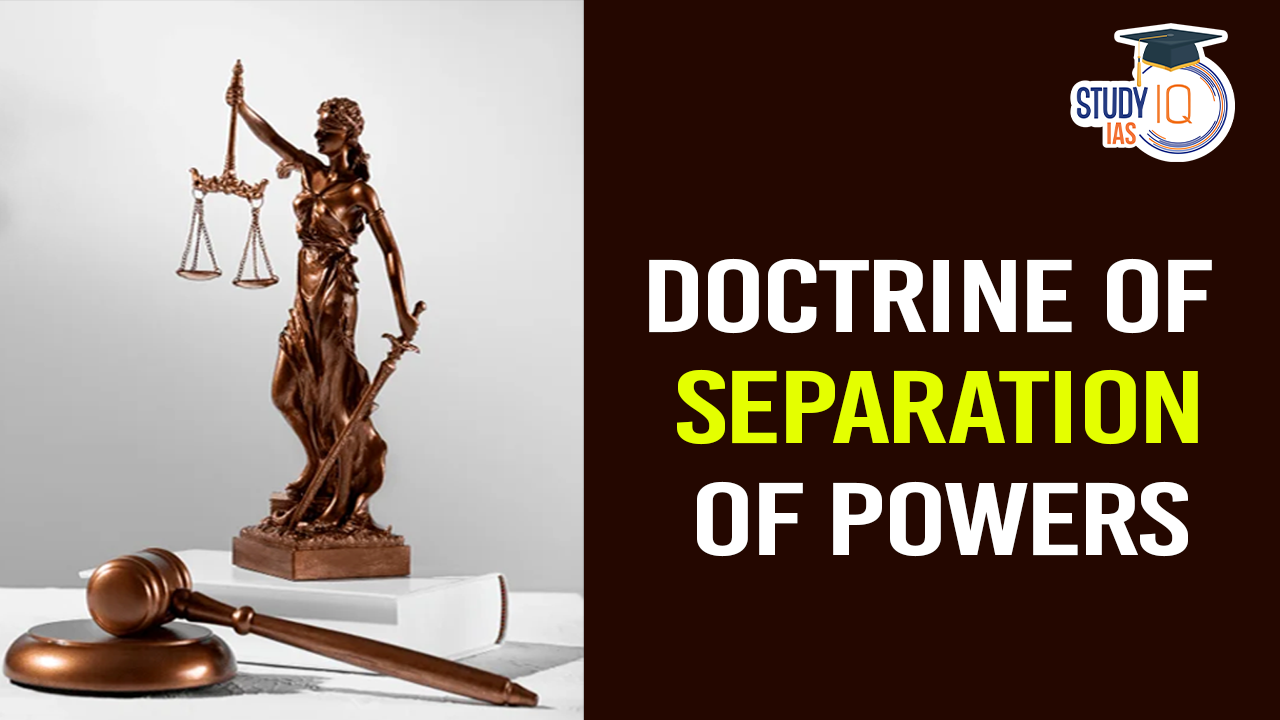Table of Contents
The Supreme Court recently upheld the principle of checks and balances by issuing several key rulings culminating in the doctrine of separation of powers in India.
About Doctrine of Separation of Powers
- This doctrine divides the government into three branches: the Legislature, the Executive, and the Judiciary.
- Each branch has distinct and independent powers and areas of responsibility to prevent any one branch from exercising the core functions of another.
- Thinkers View’s:
- Aristotle: Identified the three branches of government in “The Politics,” emphasising the need for separate functions in governance.
- John Locke: In the 17th century, proposed a model where the legislative branch held predominant power, with the executive under the control of a monarch.
- Baron de Montesquieu: In the 18th century, further refined the concept in “The Spirit of Laws,” advocating for equal and independent branches to safeguard liberty and prevent tyranny, influencing the U.S. Constitution.
Implementation in the Indian Constitution
- Influences: India’s parliamentary system is based on the British model but incorporates lessons from the U.S., especially in establishing a strong and independent judiciary.
- Judicial Review: The judiciary has the power to review the actions of the legislature and executive, ensuring they do not violate the constitution.
- Constitutional Provisions:
- Executive Power: Articles 53(1) and 154 vest executive powers in the President and the Governors, respectively.
- Legislative Immunity: Articles 122 and 212 protect legislative proceedings from judicial scrutiny, while Articles 105 and 194 protect freedom of speech within Parliament and state legislatures without judicial interference.
- Judiciary Independence: Article 50 advocates for the separation of the judiciary from the executive. Article 245 allows for law-making powers distributed between Parliament and state legislatures.
- Judicial Conduct and Immunity: Articles 121 and 211 prohibit legislative discussions on the conduct of judges. Article 361 provides legal immunity to the President and Governors in their official capacities.
Checks and Balances
- Recent Supreme Court Actions: Reinforced checks and balances by annulling the Chandigarh mayoral poll results, reversing a rule weakening forest protection, and abolishing electoral bonds.
- Protection of the Constitution’s Basic Structure:
- Historical Cases: The concept of a constitutional basic structure was solidified in the Kesavananda Bharati case, where the Supreme Court ruled that Parliament’s power to amend the constitution is limited by the need to preserve its basic structure.
- Judicial Oversight: Through various rulings, the Supreme Court has acted as a guardian of the constitution, ensuring that neither the executive nor the legislature oversteps its boundaries or violates the basic structure.
Doctrine of Separation of Powers
- Separation of powers is the division of the legislative, executive, and judicial functions of government.
- Article 50 states that states shall take steps to separate the Judiciary from the Executive.
- The constitutional demarcation through separation of power prevents the concentration of excessive power by any branch of the government.
- The Indian Constitution lays down the structure and defines and determines the role and functions of every organ of the State and establishes norms for their inter-relationships and checks and balances.
Issues with the Separation of Powers
- Weakened Opposition in India: Democracy works on the principle of checks and balances. It is these checks and balances that prevent democracy from turning into majoritarianism.
- In a Parliamentary system, these checks and balances are provided by the opposition party.
- However, the majority of a single party in the Lok Sabha has diminished the role of an effective opposition in the Parliament.
- Judicial Opposition: The Supreme Court has held the 99th constitutional amendment, which provided for the establishment of the National Judicial Appointments Commission as ultra vires.
- The NJAC could guarantee the independence of the system from inappropriate politicization, strengthen the quality of appointments, enhance the fairness of the selection process, promote diversity in the composition of the judiciary, and rebuild public confidence in the system.
- Excessive Judicial Activism: In many recent judgments, the SC has become hyper-activist in making judgements that are deemed as laws and rules. This transgresses the domain of legislature and executive.
- Executive Excesses: The executive in India is accused of over-centralisation of power, weakening of public institutions and passing laws to strengthen law, order & security of the state but curbing freedom of expression as well.


 How RBI Responded To Global Trade War Ch...
How RBI Responded To Global Trade War Ch...
 Why Confidence in US Dollar is Falling?
Why Confidence in US Dollar is Falling?
 Repo Rate and Reverse Repo Rate, Impact ...
Repo Rate and Reverse Repo Rate, Impact ...





















